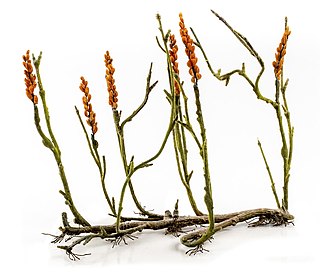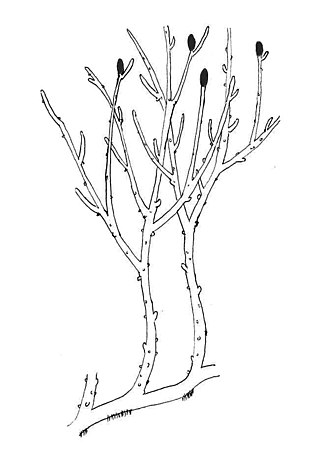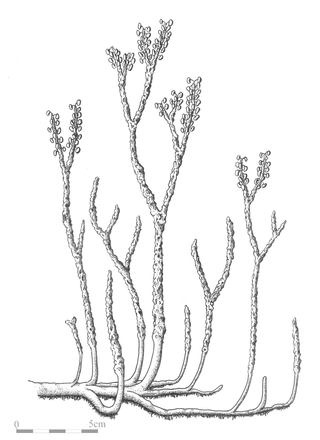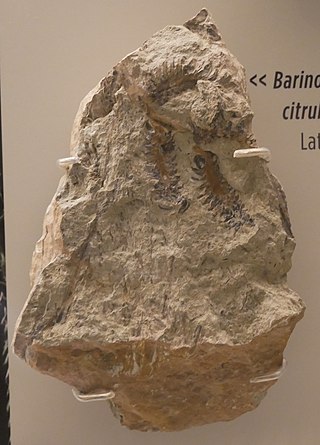
The lycophytes, when broadly circumscribed, are a group of vascular plants that include the clubmosses. They are sometimes placed in a division Lycopodiophyta or Lycophyta or in a subdivision Lycopodiophytina. They are one of the oldest lineages of extant (living) vascular plants; the group contains extinct plants that have been dated from the Silurian. Lycophytes were some of the dominating plant species of the Carboniferous period, and included the tree-like Lepidodendrales, some of which grew over 40 metres (130 ft) in height, although extant lycophytes are relatively small plants.

The zosterophylls are a group of extinct land plants that first appeared in the Silurian period. The taxon was first established by Banks in 1968 as the subdivision Zosterophyllophytina; they have since also been treated as the division Zosterophyllophyta or Zosterophyta and the class or plesion Zosterophyllopsida or Zosteropsida. They were among the first vascular plants in the fossil record, and had a world-wide distribution. They were probably stem-group lycophytes, forming a sister group to the ancestors of the living lycophytes. By the late Silurian a diverse assemblage of species existed, examples of which have been found fossilised in what is now Bathurst Island in Arctic Canada.

The rhyniophytes are a group of extinct early vascular plants that are considered to be similar to the genus Rhynia, found in the Early Devonian. Sources vary in the name and rank used for this group, some treating it as the class Rhyniopsida, others as the subdivision Rhyniophytina or the division Rhyniophyta. The first definition of the group, under the name Rhyniophytina, was by Banks, since when there have been many redefinitions, including by Banks himself. "As a result, the Rhyniophytina have slowly dissolved into a heterogeneous collection of plants ... the group contains only one species on which all authors agree: the type species Rhynia gwynne-vaughanii". When defined very broadly, the group consists of plants with dichotomously branched, naked aerial axes ("stems") with terminal spore-bearing structures (sporangia). The rhyniophytes are considered to be stem group tracheophytes.

Zosterophyllum was a genus of Silurian-Devonian vascular land plants with naked branching axes on which usually kidney-shaped sporangia were arranged in lateral positions. It is the type genus for the group known as zosterophylls, thought to be part of the lineage from which modern lycophytes evolved. More than 20 species have been described.
Crenaticaulis was an early genus of slender, dichotomously branching, leafless land plants, known from the Devonian period and first described in 1969. They were probably allied to the zosterophylls, and are assigned to subdivision Zosterophyllophytina, or class Zosterophyllopsida. They bore branches and scalariform tracheids.

Sawdonia is an extinct genus of early vascular plants, known from the Upper Silurian to the Lower Carboniferous. Sawdonia is best recognized by the large number of spikes (enations) covering the plant. These are vascular plants that do not have vascular systems in their enations. The first species of this genus was described in 1859 by Sir J. William Dawson and, was originally attributed to the genus Psilophyton. He named this plant Psilophyton princeps. In 1971 Francis Hueber proposed a new genus for this species due to its "Divergent technical characters from the generic description for Psilophyton." The holotype used for description is Dawson Collection Number 48, pro parte, Museum Specimen Number 3243. Sir J. William Dawson Collection, Peter Redpath Museum, McGill University, Montreal, Quebec, Canada.

Adoketophyton is a genus of extinct vascular plants of the Early Devonian. The plant was first described in 1977 based on fossil specimens from the Posongchong Formation, Wenshan district, Yunnan, China. These were originally named Zosterophyllum subverticillatum; later the species was transferred to a new genus as Adoketophyton subverticillatum. One cladistic analysis suggested that it is a lycophyte, related to the zosterophylls. Other researchers regard its placement within the vascular plants as uncertain.
Discalis is a genus of extinct vascular plants of the Early Devonian. The name is derived from the Greek δίσκος, referring to the disc-shaped sporangia. The genus was first described by Hao in 1989 based on fossil specimens from the Posongchong Formation, Wenshan district, Yunnan, China.
Hsua is a genus of extinct vascular plants, known from the Devonian. The name of the genus honours the Chinese palaeobotanist, Jen Hsü (徐仁).
Gosslingia was a genus of Early Devonian land plant with branching axes. Fossils have been from the Lochkovian to the Pragian, 420 to 411 million years ago.
Oricilla was a genus of Early Devonian land plant with branching axes. Fossils have been found from the Pragian to the Emsian.

Nothia was a genus of Early Devonian vascular plants whose fossils were found in the Rhynie chert in Scotland. It had branching horizontal underground stems (rhizomes) and leafless aerial stems (axes) bearing lateral and terminal spore-forming organs (sporangia). Its aerial stems were covered with small 'bumps' (emergences), each bearing a stoma. It is one of the best described early land plants. Its classification remains uncertain, although it has been treated as a zosterophyll. There is one species, Nothia aphylla.

Barinophyton was a genus of early land plant with branching axes. It is placed in a group of early vascular plants (tracheophytes), the barinophytes, a group that has been given various ranks and scientific names. Known fossils are of Devonian to Carboniferous age.
Protobarinophyton was a genus of Silu-Devonian land plant with branching axes. It is placed in a group of early vascular plants (tracheophytes), the barinophytes, a group that has been given various ranks and scientific names.
Wenshania is a genus of extinct vascular plants found in the Posongchong Formation, Yunnan, China, which is of Early Devonian age. Plants consisted of leafless stems with simple dichotomous branching, and bore spore-forming organs or sporangia all around the sides of stems. Wenshania is part of the broadly defined group of zosterophylls.
Gosslingiales is an order of extinct zosterophylls. The zosterophylls were among the first vascular plants in the fossil record, and share an ancestor with the living lycophytes. The group has been divided up in various ways. Hao and Xue in 2013 used the presence or absence of terminal sporangia as a major dividing feature. The order Zosterophyllales was used for species with terminal as well as lateral sporangia, which were considered to have determinate growth, with their sporangia generally being arranged in spikes. The paraphyletic order Gosslingiales was used for species without terminal sporangia, which were considered to have indeterminate growth, with fertile branches generally circinate. Species assignable to the Gosslingiales made up about 9% of all confirmed species in the Early Devonian flora.
Gosslingiaceae is a family of extinct zosterophylls. The zosterophylls were among the first vascular plants in the fossil record, and are considered to share an ancestor with the living lycophytes. The family is variously placed in the order Sawdoniales or the order Gosslingiales.

Sawdoniaceae is a family of extinct zosterophylls. The zosterophylls were among the first vascular plants in the fossil record, and are considered to share an ancestor with the living lycophytes. The family is recognized by some sources, and placed in the Sawdoniales. Other sources do not recognize the family, and place some of its members in the family Gosslingiaceae.
The barinophytes are a group of extinct vascular plants (tracheophytes). Their relationship with other vascular plants is unclear. They have been treated as the separate class Barinophytopsida, the order Barinophytales of uncertain class and as a family or clade Barinophytaceae within the zosterophylls. They have also been considered to be possible lycopodiopsids.
Ramoferis is a genus of extinct vascular plants of the Pragian stage of the Early Devonian, around 413 to 411 million years ago. It is considered to be a zosterophyll, one of a group of plants that were related to the ancestors of the modern lycopsids. Fossils were found in the Posongchong Formation in Guangnan County, Yunnan, in southwestern China, where they occur as compressions.









